Speaking after the publication of the results, chief executive Martin Sutherland confirmed that De La Rue's R&D team is working on an alternative substrate, which is expected to be ready for market in the next couple of months.
The original polymer notes went into circulation in September last year. However, the revelation that the substrate used by the Bank of England contained trace quantities of tallow, an animal byproduct prompted an online petition – currently signed by around 137,000 people – for the material to be changed. This also resulted in a rethink at De La Rue regarding its own substrate.
Sutherland also confirmed that De La Rue is currently in the tender process for the printing of the new UK passport, whose current £400m contract is held by the group and is due to expire in 2019.
He added: “It’s been a very successful collaboration and I guess in the context of Brexit our hope is moving forwards the British passports will be printed by a British company.”
In the year ending 25 March 2017, overall revenues for the group increased by 2% on last year's figure, from £454.5m to £461.7m, with adjusted operating profit increasing very marginally to £70.7m. Adjusted profit before tax again rose marginally to £58.7m while adjusted earnings per share saw a 2% drop, from 48.1p to 47.1p.
The group completed the acquisition of US-based DuPont Authentication for £21.3m on 6 January 2017 after entering into a share purchase agreement to acquire 100% of its outstanding capital stock on 12 December 2016. DuPont specialises in photopolymer holographic films and 3D holograms and associated software, mainly feeding the brand protection and passport markets.
Integration has now been fully completed and DuPont Authentication has been renamed De La Rue Authentication Solutions (DAS), with all 40 staff kept on at DAS’ sites in Utah and Delaware.
Sutherland said that the group is in the process of changing the formfactor of DAS’ holograms so that the material can be used in banknotes.
He said: “We’re very pleased with the performance of the business. The strategy was set out a couple of years ago to focus on a number of growth areas. The one that stood out was growth in Product Authentication & Traceability (PAT) and that has certainly come through this year with increased investment in R&D and the DuPont acquisition. We are the biggest commercial producer of passports in the world.
“We’ve got a good organic strategy but if we see the opportunity for more bolt-on acquisitions, which bring something to the business, then we will consider it.”
Costs of £900,000 were incurred related to the acquisition, including £500,000 of professional advisor fees and £400,000 of exceptional items.
The PAT division saw an increase of 20% in sales to £34.6m and adjusted operating profit rose by 29% to £9m. Excluding the DuPont acquisition, revenue in the segment would have grown by 13% and adjusted operating profit by 24%.
In its currency business, which comprises banknote print, banknote paper, polymer and security features, revenues fell 1%, to £353.3m, while adjusted operating profit also fell just shy of 10%, from £55.1m to £50.3m.
Sutherland said that while the currency business had benefited from higher banknote paper volumes and a quadrupling of polymer production to 380 tonnes, this was offset by the impact of the conclusion of a security features contract.
Polymer volumes quadrupled as De La Rue became supplier to two “volume issuers”, one using the material for the first time and the other where De La Rue “displaced the competition to become supplier”, according to Sutherland.
The Identity Solutions division saw a 5% increase in revenue (from £76.5m to £80.6m) and a 37% boost in adjusted operating profit, hitting £11.4m for the end of the year.
The group’s pension deficit rose to £196.7m, an increase of 10% on last year’s figure.










